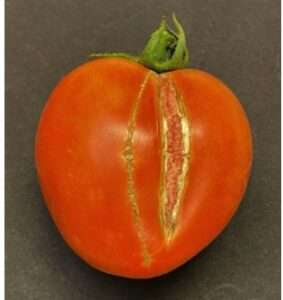As reported in High Plains Journal. Gardeners might notice that their tomatoes are cracking or splitting now. “This is a common problem when there are widely varying soil moisture conditions, especially during the hot, dry days of late summer,” says University of Missouri Extension horticulturist David Trinklein.
Too much irrigation or heavy rainfall after a dry period results in rapid uptake of water in plants. This causes ripening fruit to split vertically or crack concentrically, says MU Extension horticulturist Michele Warmund.
Tomatoes exposed to direct sun tend to absorb more heat during the day than shaded fruit and are more prone to splitting. Also, tomatoes left on vines too long often crack at the stem end of the fruit.
There are several ways to reduce tomato cracking, says Warmund. Provide plants a consistent supply of moisture by hand watering or irrigating with soaker hoses. Drip irrigation tape can also help. Conserve soil moisture by mulching the area with straw, compost or other material. Maintain optimum plant fertility by applying calcium nitrate and other nutrients, especially during flowering and fruiting. Too much nitrogen or not enough calcium and/or potassium predisposes the tomatoes to cracking.
If rain is expected after a droughty period, harvest any nearly ripe tomatoes. Fruit may not be quite as flavorful as a fully, vine-ripened tomato, but they will still be usable. After the rainfall, harvest any cracked or split fruit immediately and use it quickly before rot develops. Discard any sour-smelling, diseased or rotted portions of the fruit.
Breeders have developed several cultivars that resist cracks, Trinklein says. However, all tomato cultivars, including cherry, plum and conventional types, are prone to this problem when dry soil conditions are followed by abundant moisture.




